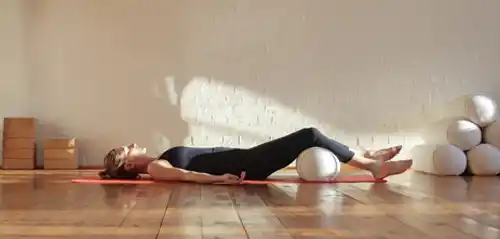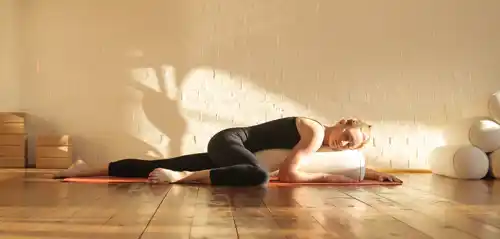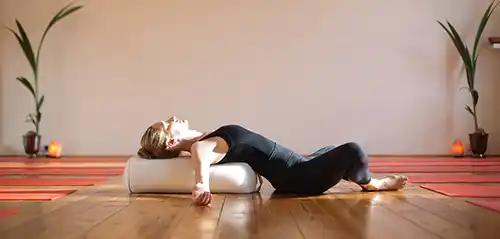Want to buy a yoga bolster? A guide.
In this blog we explore the versatility and benefits of the yoga bolster. Why you would want to use a yoga bolster, for which poses and when. And more importantly: how to choose the best yoga bolster; the bolster that perfectly suits your personal needs and practice.
Why you (sometimes) need a yoga bolster
A yoga bolster is not used in every yoga class, but sometimes this versatile accessory is indispensable. A yoga bolster can give you a few important extras, such as:
- Extra support
For some poses, a yoga bolster can help you remain relaxed in a pose for a long(er) time, while this would be impossible without a bolster. Consider, for example, a Pashimottanasana Yin Yoga, where you bend forward for a longer period of time with your legs stretched out. With the support of a bolster you can really find relaxation in this posture and surrender more deeply to the posture. And this allows the benefits of the pose to be reaped more fully.
- Extra Comfort and Extra Relaxation
In addition to support, a bolster also works very well for deepening relaxation in some poses. For example, consider Savasana where you place the bolster under your knees so that your back can stretch and relax even better.
- Extra Deep Stretch
In some poses, a bolster can help you stretch deeper in a way that would not be possible without a bolster. Consider, for example, the forward bend mentioned above for a deep stretch of your hamstrings, or a lying back bend in which the bolster is placed under the upper back, thus allowing the chest to be opened further.
- Extra Safety
A bolster can help adapt many poses exactly to your personal needs, build strength and flexibility, and prevent injuries.
When do you use a yoga bolster?
It largely depends on your yoga style whether you will often use a bolster or not. In some forms of yoga, such as Ashtanga Yoga, they will not be used at all. But with other (often quiet) yoga styles such as Hatha, Restorative and Yin yoga you will find that you simply cannot do without it.
Bolsters are most commonly used in poses such as Savasana, supported backbends, supported forward bends, child's pose, but also many others where extra support is required.
In addition, a yoga bolster is also often used during recovery from injuries, to relieve tension after a long day or simply when you need a gentle and relaxing (Restorative) practice.
How do you use a yoga bolster?
A bolster is always placed under a certain part of your body for support and (sometimes) to increase the depth of the stretch. For example, under your lower back during a lying backbend.
You can experiment with the position of the bolster for each pose to see what works best for your body and needs. A bolster can be used transversely, diagonally or lengthwise. A rectangular bolster often also has a high and a lower side, allowing you to vary in height. Some studios offer you the choice between harder and softer bolsters, so if so, try them both out to discover what works best for you and feels most comfortable.
There are many different and creative ways to integrate bolsters into your yoga practice, such as using them to support breathing exercises. You can also use your bolster outside your yoga mat, for example to find a soothing sleeping position or as a seat cushion during meditation.
Yoga bolster alternatives
And if you don't have a yoga bolster (yet), you can use alternative accessories to try out which support works well for you. Consider 1 or 2 meditation cushions, a (double-folded) meditation mat, a foam roller or even a set of yoga blocks. How hard/soft should the support be, what height is most comfortable?
What do you pay attention to when buying a yoga bolster?
Size; high or low
Consider the intensity of support you need and the poses you want to explore. A higher bolster usually provides more support and a deeper stretch, while a lower bolster is a bit milder.
Shape; round or rectangular
A round bolster is often a bit higher and is easy to position. This minimally interrupts the flow of your yoga practice. A rectangular bolster usually has a high and a lower side, which allows you to vary more in the height of the support.
Weight; lightweight or heavier
A lightweight bolster is important if you want to transport it often, for example if you use it both at home and in the yoga studio. A heavier bolster, on the other hand, usually offers more stability and support, and is also less soft.
Material; buckwheat, cushion filling or foam
- A yoga bolster filled with buckwheat is usually quite heavy, but very stable. These bolsters are usually very firm, but do not give much to the body. Buckwheat hulls are a natural product and should not become damp.
- Bolsters filled with cushion filling (cotton or synthetic) are lighter in weight, softer and adapt more to the body. An important advantage of this material is that the filling of these bolsters is also washable and can be easily refilled.
- Finally, there are also bolsters with a combination filling. The core is then made of foam, which provides a lightweight but very sturdy base. Surrounding it is a layer of cushion filling, which makes the bolster feel pleasant and soft and molds well to the body.
Here too, experiment with which material, which height, and especially which softness or firmness is ideal for you. Don't forget to check whether the cover is easily removable and whether you can wash it out easily.
Which yoga bolster do you choose?
Depending on the yoga style you practice, a yoga bolster can be a very valuable addition to your yoga practice. It increases your comfort, stretch and relaxation in many yoga poses. Whether you are recovering from an injury, want to stretch deeper or just completely relax, a yoga bolster will help!
Do you want to get started with a yoga bolster? We have put together a fine selection of yoga bolsters for you from Manduka and Love Generation.
Keep experimenting, keep listening to your body and always remember to adapt your practice to your needs. Have fun and enjoy your yoga journey!











